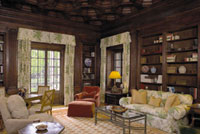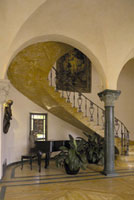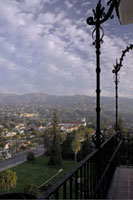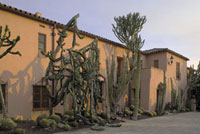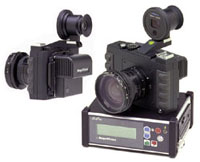The Horseman DigiWide
Professional digital photography with single shot backs for medium format SLRs has had an inherent limitation. Because the area size of the digital CCD chip is smaller than that of the camera's film format the angle of view is narrowed. This makes lenses effectively longer in focal length largely eliminating wide angle photography. Horseman's new DigiWide is a camera body designed to use Nikkor lenses on the front and a single shot digital medium format back at the rear, providing the ability to obtain true wide angle performance digitally. The DigiWide has a metal focal plane shutter adjacent to a picture plane format of 24x36mm, and built-in TTL meter. In addition an accessory Horseman optical viewfinder is available and is installed in a center-mounted shoe on top of the camera. Spirit levels are built into the body, as well as two tripod sockets, and an additional shoe mount is available for remote flash triggers and similar devices. |
|||
James Chen Uses The DigiWide With A MegaVision S3 Back And BatPac. To field test just what the Horseman DigiWide can do it was necessary, in addition to obtaining one of the first cameras produced, to bring together a top professional whose work demands wide angle photography, as well as a current SLR digital back which has support for battery operation in the field. The latter was an S3 back and the BatPac supplied by MegaVision. The BatPac is actually a dedicated computer that is driven by a laptop battery, and saves the images captured directly to a PCMCIA Type-3 340MB hard drive card. The confluence of these elements was fortuitous because James Chen is a professional photographer based in Santa Barbara, California, since 1966 servicing major national and international accounts including Atlantic Richfield, CBS, Continental Airlines, and Hewlett-Packard among others, and is also well-known for his architectural photography. In fact when this opportunity to try out the Horseman DigiWide came together, Chen was working on an exclusive project to photograph a large selection of noted examples of Santa Barbara's style of Spanish/Mediterranean architecture for Rizzoli Publications International Inc., to result in a "coffee-table" book. This made it possible for Chen to do a number of images with the DigiWide fitted with the MegaVision S3 and BatPac parallel to also making the same shots of the architecture on film for the Rizzoli book. |
|||
Besides frequently requiring the use of a wide angle lens, architecture is a subject that often demands that vertical perspective is not distorted, a usual result using a lens with a wide view. Fortunately the 28mm Nikkor Perspective Control lens can be used with the DigiWide to adjust for such contingencies. Architectural photography, particularly interiors, can be demanding in other ways as well. Unlike product illustration and portraiture typical of studio photography, an interior often involves a long range of brightness values as well as a requirement to preserve detail in the extremes of highlights and shadows. That this exposure latitude is kept within the range of film or a CCD's recording capabilities is usually done by the addition of extra lighting inside, as well as very careful timing to match the level of the outdoor illumination when a shot looks through windows to what's beyond. To create this balance in a realistic manner interior photographers like Chen may replace the light bulbs in interior lamps with brighter ones, and use a studio flash to provide fill illumination in the room, also carefully balanced with the interior lighting and any window light. So, besides demonstrating the capabilities of the Horseman DigiWide, Chen's work put Mega-Vision's S3 digital back to the test of a different kind of subject and lighting. |
|||
What Is The State Of The Art? First of all, the Horseman DigiWide is quite typical of the company's excellence of design and execution. If it were anything less, Chen would have been most aware of it as he has been using Horseman's large format cameras for some years. The potential quality of images made with the MegaVision S3 is also well established applied to subjects shot in the studio proving sharply defined detail and fine gradation of tone, as well as a high degree of color fidelity to the subject. These attributes were evident in the images Chen produced with the DigiWide and the MegaVision S3/ BatPac outfit. However, the fact the MegaVision back was designed for a medium format SLR with TTL viewing and focusing leaves those functions somewhat wanting with the back working on the DigiWide. Workarounds to this are first adding the Horseman Optical viewfinder, which was provided, and also having a Nikon body at hand to check initial framing and focus distance. However, this situation will not be for long as MegaVision is in development of a live viewfinder feeding directly from the CCD chip in the S3 back. Finally, the subjects Chen photographed, utilizing his extensive experience working with film did not yield "identical" digital results. That simply reflects the fact the response curve of film and a CCD chip are different. This is something which must be accommodated as experience is acquired, but which to a large extent can be adjusted for with a little tweaking in Photoshop. The bottom line is not so much whether a photographer will want the new Horseman DigiWide, but will the clients who commission work that demands use of a wide angle require that work be delivered digitally. In other words, relatively few photographers have pro-actively switched to digital, most who now use digital in the studio have done so in response to customer preference and economic advantage. Regard-less of the reason, the Horseman DigiWide is a well conceived and executed solution to extending the optical range of medium format digital backs like the MegaVision S3. Manufacturers/Distributors Horseman USA MegaVision |
|||
Technical Specifications Horseman DigiWide MegaVision S3 |
